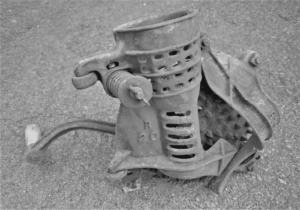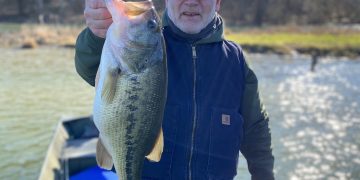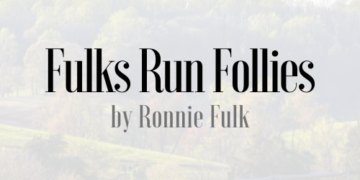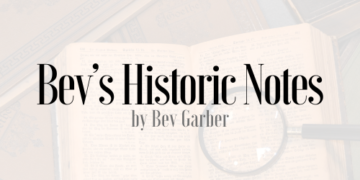When the leaves of the corn began to turn brown, it was time to think about getting it cut. I first remember seeing it cut by hand with a hand-held corn chopper. The choppers, shown below were made at the Mills Blacksmith Shop in Hupp, Va. When harvesting, every so many rows across the field were designated shock rows. Someone would first go through the field and tie saddles using the corn stalks in a square, opposite each other and tying them together for each corner of the shock.
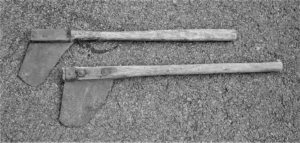
Corn was planted in hills usually 3 ft. apart. First a wire was stretched down the length of the field that had wire knots incorporated in it, every so far apart. There was a mechanism on the corn planter that when a knot slid through it, the action would trip the planter to drop corn seeds down a chute to be planted in the ground. The shape of the wheel on the corn planter would cover the seeds with dirt. At the end of each row you had to move the wire over for the next pass across the field. That was quite a job if you had a sizable field.

You would cut the corn with a hand held corn chopper and set your arm full of corn stalks up in the saddle. When you got enough corn to make a shock you would draw it tight with a cincher and rope. It was much easier to use a rope instead of string for this. After you would have it cinched tight, you would tie it with string. Then remove the cincher and rope to be used on the next shock. Then work toward the next corn shock saddle cutting more corn.
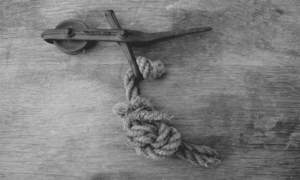
Later on my grandfather designed a corn cutting sled that two people rode on. One person on each side of a center beam and pulled by one horse. The horse would walk between the rows of corn and the person on the sled would catch an armful of corn. The knives were attached on the edge of the floor of the sled. It severed the stalk off while being caught in one of the persons arms where he would jump off and place the arm full of stalks in the pre-tied saddle. It went much faster this way. OSHA would sure frown on this set-up.
The knives were made from iron buggy tires in the blacksmith shop.
The corn shocks would sit in the field until winter, letting them dry out. Then on a cold winter day when you had nothing to do, you and the kids would go to the cornfield to shuck corn. Or send just the kids, a form of punishment.
I know a little kid (me) who went to shuck corn one day, got sleepy and curled up in the shock and went to sleep. He didn’t have much to show for his days work of shucking corn.
Most of the time when you got through shucking a shock of corn the procedure we used was to retie the stalks into bundles and then cover the pile of ear corn with bundles of the corn stalks so the deer and crows wouldn’t eat it. Then, at a later time we would go and gather the piles of ear corn (see top of page 85 in my book “Hupp, Va., where I got my start”) and take it to Plains Mill to have ground to be put in feed. We also would store some of the whole ears of corn in our granary for later use.
This however, gave the varmints, especially field mice a place to congregate and it sure made it interesting for the dogs when we came to get the corn!
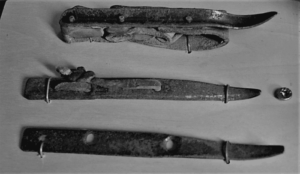
When you are cutting an armful of corn (called hugging) you have to be on the lookout for stinging insects. One that comes to mind is the larva of the Saddle-back Moth. It has a burgundy saddle across it’s back, approximately 1 inch long and very pretty. It’s food is corn leaves. Also a Saturnid, the io Moth, Automeris io. It is approximately 2 inches long and bright green with a pink and white stripe down its side. It turns to yellow when nearing pupation. Both make beautiful moths. DO NOT TOUCH THESE TWO LARVAE, (worms to most people). The sting of both of those larvae really hurts. They actually don’t sting, its when you touch their bristles. It feels and hurts like a sting. Contact with these worms causes painful burning sensations, as the skin becomes inflamed.
Every part of the corn stalk was consumed. We wasted nothing. We fed corn shucks, fodder, and stalks to the cows. Good ears were fed to the horses. The horses would shell their own ears of corn. We used some of the best ears to grind for making corn bread.
Ears of corn were fed directly to the hogs, the cows were given nubbins, (stunted undeveloped ears). Shelled corn was fed to chickens, guineas, and ducks. Even the corn cobs were used for kindling and fuel for kitchen stove.
We later bought a hand cranked corn sheller that made shelling the corn easier.
